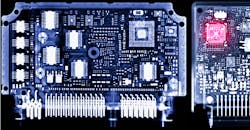Better Boards Lead to Safer Cars (.PDF Download)
With the spotlight shining brighter on autonomous driving, 5G and cellular-vehicle-to-everything (C-V2X) breakthroughs grab the headlines when it comes to reporting how to better test self-driving cars. Behind this exciting and somewhat glamourous buzz is a robust automotive electronics manufacturing services (EMS) industry that’s physicalizing the technology innovations.
In recent years, automotive EMS providers are increasing their operational efficiency to cope with complex printed-circuit-board assemblies (PCBAs) that go into electronic systems behind intelligent transport systems. These include sensors, electronic control units (ECUs) for powertrains, advanced driving-assistance systems (ADAS), comfort features like sensor-controlled temperature controls and adjustable seats, infotainment, and new applications for planned C-V2X capabilities. Such applications will drive the automotive electronics industry towards the $400 billion mark over the next five years.
